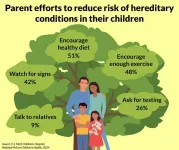(Press-News.org)
Researchers from the Institute of Process Engineering (IPE) of the Chinese Academy of Sciences have developed a sustainable, biodegradable, biorecyclable material: high-entropy non-covalent cyclic peptide (HECP) glass. This innovative glass features enhanced crystallization-resistance, improved mechanical properties, and increased enzyme tolerance, laying the foundation for its application in pharmaceutical formulations and smart functional materials. This study was published in Nature Nanotechnology on Aug. 26.
Glass materials have long been integral to technological and cultural advancements due to their versatile properties, such as optical clarity and chemical stability. However, conventional glass materials often rely on strong ionic and covalent bonds, which pose challenges related to toxicity, resource depletion, and environmental persistence. In response, researchers have been striving to develop next-generation glass materials that prioritize biodegradability, biorecyclability, and sustainability.
A research team led by Prof. YAN Xuehai from IPE has pioneered the development of biodegradable, biorecyclable glasses based on amino acid and peptide components. These innovative biomolecular non-covalent glasses offer a sustainable alternative to the traditional glasses and plastics, promising both environmental and ecological benefits. However, developing a stable non-covalent glass that performs well under challenging physiological conditions while minimizing rejection has been a challenge.
Cyclic peptides (CPs), characterized by a cyclic backbone connecting the amino and carboxyl ends, exhibit diverse biological activities, enhanced stability and resistance to enzymatic degradation compared to their linear counterparts. This makes CPs a promising platform for developing non-covalent glass for biomedical or other high-tech applications. However, their strong tendency to crystallize has limited their potential in glass technology.
To overcome this obstacle, the research team developed a novel method to achieve stable non-covalent glass based on CPs. This approach, termed a high-entropy strategy, involved incorporating a diverse range of CPs to create a high-entropy environment that effectively inhibited crystallization. The CPs underwent a melting-quenching process, where they were heated above their melting points and then rapidly cooled to preserve the disordered conformations in a supercooled liquid state, ultimately leading to the formation of glass. Notably, the principles underlying this strategy are broadly applicable to the preparation of high-entropy non-covalent glass composed of other small organic molecules.
The resulting HECP glass exhibits enhanced crystallization-resistance, improved mechanical properties, and greater enzyme tolerance compared to individual cyclic peptide or linear peptide glasses. These improvements stem from the synergistic effect of sluggish diffusion and hyperconnected network architectures within the HECP glass. Moreover, these properties can be tailored through compositional adjustments, making HECP glass a promising candidate for drug delivery systems where controlled release is essential. Additionally, HECP glass has already demonstrated the potential to incorporate other functional moieties, such as dyes and nanoparticles, contributing to the design and development of multifunctional, sustainable, non-covalent glasses.
"The high-entropy strategy has proven to be an effective method for achieving stable non-covalent glasses, though it is still confined to laboratory settings at this stage," said Prof. YAN.
Looking ahead, further research is needed to explore the full potential of HECP glass in various applications, including the development of HECP glasses with even higher thermal stability, the incorporation of additional functional groups to enhance their optoelectronic properties, and the exploration of alternative synthesis methods that avoid the use of organic solvents or high temperatures.
END
Malaria is caused by a eukaryotic microbe of the Plasmodium genus, and is responsible for more deaths than all other parasitic diseases combined. In order to transmit from the human host to the mosquito vector, the parasite has to differentiate to its sexual stage, referred to as the gametocyte stage. Unlike primary sex determination in mammals, which occurs at the chromosome level, it is not known what causes this unicellular parasite to form males and females. New research at Stockholm University has implemented high-resolution genomic tools to map the global repertoire of genes ...
Climate scientists have long agreed that humans are largely responsible for climate change. However, people often do not realize how many scientists share this view. A new 27-country study published in the journal Nature Human Behaviour finds that communicating the consensus among scientists can clear up misperceptions and strengthen beliefs about climate change.
The study is co-led by Bojana Većkalov at the University of Amsterdam and Sandra Geiger of the University of Vienna. Kai Ruggeri, professor of health policy and management at Columbia University Mailman School of Public Health, is the corresponding author.
Scientific consensus identifying humans as primarily ...
Artificial intelligence (AI) has practically limitless applications in healthcare, ranging from auto-drafting patient messages in MyChart to optimizing organ transplantation and improving tumor removal accuracy. Despite their potential benefit to doctors and patients alike, these tools have been met with skepticism because of patient privacy concerns, the possibility of bias, and device accuracy.
In response to the rapidly evolving use and approval of AI medical devices in healthcare, a multi-institutional team of researchers at the UNC School of Medicine, Duke University, Ally Bank, Oxford University, Colombia University, and University of Miami have been on a mission to build ...
High levels of traffic-related air pollutants have been linked with elevated risks of developing cancer and other diseases. New research indicates that multiple aspects of structural racism—the ways in which societal laws, policies, and practices systematically disadvantage certain racial or ethnic groups—may contribute to increased exposure to carcinogenic traffic-related air pollution. The findings are published by Wiley online in CANCER, a peer-reviewed journal of the American Cancer Society.
Most studies suggesting that structural racism, which encompasses factors such as residential segregation and differences in economic status and homeownership, may influence ...
ANN ARBOR, Mich. – Among things many families don’t wish to pass down to their children and grandchildren: medical issues.
One in five parents say their child has been diagnosed with a hereditary condition, while nearly half expressed concerns about their child potentially developing such a condition, a new national poll suggests.
And two thirds of parents want their healthcare provider to suggest ways to prevent their child from developing a health problem that runs in the family, according to the University of Michigan Health C.S. Mott Children’s Hospital National ...
by Amy Norton
PISCATAWAY, NJ – After years of being seen as dangerous “party drugs,” psychedelic substances are receiving renewed attention as therapies for addiction -- but far more research is needed, according to a new special series of articles in the Journal of Studies on Alcohol and Drugs, published at Rutgers University.
Psychedelics are substances that essentially alter users’ perceptions and thoughts about their surroundings and themselves. For millennia, indigenous cultures have used plants with psychedelic properties in traditional medicine and spiritual rituals. And for a time in the mid-20th ...
Amid the rising human population and pressure on food supplies, the world can’t be everyone’s oyster. But perhaps there might be more oysters to eat if an Osaka Metropolitan University-led research team’s findings mean sturdy plastic rafts will be used in their farming.
Conventional oyster farming uses bamboo rafts with additional flotation devices such as Styrofoam. Though relatively affordable, these rafts can be damaged in typhoons. The OMU-led researchers propose a polyethylene raft that keeps costs manageable but is about five times more durable than a bamboo raft.
OMU Graduate School of Engineering Associate ...
Despite increased funding for cataract surgeries to private, for-profit clinics, access to surgery fell 9% for lower-income people, according to new research published in CMAJ (Canadian Medical Association Journal) https://www.cmaj.ca/lookup/doi/10.1503/cmaj.240414.
“Unexpectedly, despite new public funding for operations provided in private for-profit surgical centres, which was intended to fully cover all overhead costs and remove the need to charge patients, this disparity did not decrease, but instead grew ...
With tick-borne viruses such as Powassan virus increasing in Canada, clinicians should consider these infections in patients with encephalitis, as a case study shows in CMAJ (Canadian Medical Association Journal) https://www.cmaj.ca/lookup/doi/10.1503/cmaj.240227.
Although rare, Powassan virus is serious, with a death rate of 10%–15% in people with encephalitis, and it can cause lingering health effects after infection. The virus can transmit within 15 minutes of tick attachment, and symptoms can develop 1–5 weeks later.
In this case study, a 9-year-old child with up-to-date vaccinations ...
EMBARGOED UNTIL 12:01 A.M. AUGUST 26, 2024
NOTE TO EDITOR: (To download broadcast-quality video and other multimedia elements: https://bit.ly/3M2ljhX (password: naloxone)
COLUMBUS, Ohio – International Overdose Awareness Day is a worldwide campaign held each Aug. 31 that acknowledges the grief of family and friends left behind from those who have died from a drug overdose. This year’s campaign theme “Together we can” highlights the power of the community standing together to help end overdose.
However, a new survey of 1,000 Americans from The Ohio State University Wexner Medical ...





